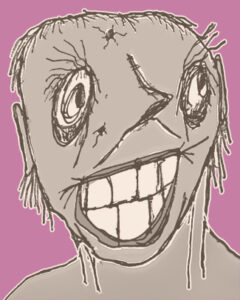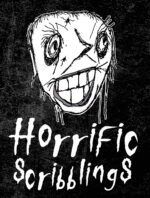Introduction and Guide: The First Extraction
by L. Andrew Cooper, editor
with Silas the Scribble Man, assistant

Welcome to The First Extraction, the premiere Exhibit from the Horrific Scribes archive of dark short fiction and (to a lesser extent) dark poetry!
Horrific Scribes receives submissions from authors around the world and accepts relatively few for its collection (so far, accepted pieces come from Canada, Hungary, Indonesia, Kenya, the U.S., and the U.K.). I publish accepted pieces as quickly as I can on this site for readers to access at any time for free.
When I feel I have enough material, I’ll put together an Exhibit. An Exhibit selects pieces from the collection to feature as a group, usually emphasizing some commonality that binds the group together such as a shared subgenre, similar themes, comparable imagery, etc. An Exhibit is like a free anthology or magazine, to be devoured with dark delight.
The First Extraction is, by virtue of being first, different from how I imagine future Exhibits. For one thing, it’s bigger–with 16 selections from 15 authors (Lena Ng included both a story and poems in a single submission, and they’re all good), it may be more than twice the size of future Exhibits.
Another major difference is that, since I’m using everything in the archive so far, the selected pieces are diverse enough to suggest the wide net Horrific Scribes casts when seeking material for its provocative, scary, and strange collection.
Within diversity, connections are always possible, so I have arranged this Exhibit into four Galleries that emphasize commonalities: Traps, Hauntings, Invasions, and Distortions, and I have ordered the pieces to highlight more connections. The rest of this introduction discusses connections and distinctions to consider as you tour the Exhibit.
GALLERY ONE: TRAPS
“Squish” by Cassandra O’Sullivan Sachar. This tale of claustrophobia and paranoia on the New York City subway stands out because it’s realistically grounded and almost purely psychological, but the tight squeeze on the platform and in the train is certainly enough to make you feel like you’re in a trap made of other human bodies.
BONUS: Interview with Cassandra O’Sullivan Sachar (2024). You’ll see that Sachar’s story is in the archive because of its own merits, but she probably heard about Horrific Scribes because I interviewed her in 2024 about a new novel, collection of stories, and collection of essays. It’s a good (written) discussion, and she’s quite accomplished, so here’s an opportunity to learn more about her and her work. This is not a trap.
“The Revenge Room” by Robb White. I don’t know whether “revenge horror” constitutes a subgenre, but a lot of great horror is about revenge, and White’s story is almost paradigmatic–except the revenge the story recounts is deeply, deeply twisted (and yes, it involves a trap, with claustrophobia in common with “Squish”). Other tales might have shades of comeuppance, but this story is the only pure revenge horror in the Exhibit.
“We Read by Rot” by Pamela Love. Love’s thrillingly bizarre tale is the only dark fantasy in the collection so far, but beyond that distinction, I’ve never read anything quite like it. She builds a haunting world for her characters with very few words and a frightening scenario in which the characters are indeed trapped.
“The Indignities” by Christine Lajewski. Though “We Read by Rot” suggests strange creatures, “The Indignities” is the only bona fide creature feature in the archive so far, and it has layers and resonance that make it much more rewarding than the average monster romp. I don’t think it fits as well as the others in the “Traps” Gallery, but I could argue that it involves many traps, from the humiliating situation in which the main character begins to the larger traps of aging and death.
GALLERY TWO: HAUNTINGS
Whispering Walls and Other Haunting Verses by Emmanuel Komen. Komen’s five poems involve creatures as well as haunting, but again and again, the poems’ speakers seem most haunted by themselves. Verse that suggests a strong ear (rhythm, rhyme, assonance, alliteration, etc.) draws me to it, and Komen’s words spin horror into music.
“The Ghost in the Casement” by Robert Runté. This story offers extra fun for readers familiar with traditional Gothic and nineteenth-century ghost stories, as Runté evokes and plays with classic tropes in a way unlike any other piece in the archive so far. However, I stop short of calling this one a “classic ghost story” because the second half’s ambiguities feel unnervingly contemporary.
“My Mother’s Way” by M. Brandon Robbins. When I announced this story, I called it “emotional horror,” as it reads like literary memoir with terror rising from childhood emotional abuse that continues into adulthood thanks to a ghost very different from Runté’s. The story is bloodless but nonetheless horrific, a potentially grueling experience, especially if you’ve got unresolved family trauma.
“Beneath the Boards” by Fendy S. Tulodo. I think this haunting is the meanest of the bunch, and Tulodo’s narrative style (and perhaps content) is the most experimental. Short sentences and paragraphs deliver the story like machine gun bullets, making the main character’s escalating dread palpable.
GALLERY THREE: INVASIONS
“Weed Killer” by Amanda M. Blake. As we move into Gallery Three, the mood changes. The atmosphere of Blake’s plant horror in “Weed Killer” feels much warmer, and this story, though horrific, makes me smile. Blake paints a grotesque picture of a community as she lets her plants grow, and then she turns toward the cosmic.
“It Gets Worse If You Pick At It” by Laura DeHaan. Stepping over to this story is a step from plant horror to fungus horror (or fungal body horror), which isn’t a huge leap, and though the inhuman invasions of “Weed Killer” and “It Gets Worse If You Pick At It” both involve sci-fi elements, I’d say here is the only place we’re firmly ensconced in dark sci-fi territory. Aliens. Ships. Colonization. Reverse colonization. Fun!
“The Imposter Syndrome” by Eric Nash. The invaders in “The Imposter Syndrome” take us away from sci-fi back toward the spiritual realm. They might even be demonic. In any case, they’re doppelgängers of the creepiest kind, in the tradition of Poe’s “William Wilson” but with a twist all Nash’s own. This one really got to me.
“Survival Instinct” by T. Fox Dunham. We lean back toward sci-fi a bit when we get to Dunham’s “Survival Instinct,” but I see the invasion in this story–though it provides occasions for some very cool, very surreal imagery–as mostly a backdrop to the more pressing issues of mortality and the will to survive that the story examines. Gut-wrenching.
GALLERY FOUR: DISTORTIONS
“Darkly Dreaming from the Abyss” by Lena Ng. “Survival Instinct” involves surreal imagery and a noirish crime aesthetic, so it belongs beside “Darkly Dreaming from the Abyss,” but Ng’s story kicks off a different gallery because it’s in a different league of surreal, oneiric, distorted, and, as Ng rightly claims, Lynchian. It also reminds me (favorably) of a certain story by Ambrose Bierce.
Seven Horrorku (Horror Haiku) by Lena Ng. Ng’s talent for distorted and disturbing imagery runs throughout the seven short poems she contributed to the archive in addition to her story.
“The Vacuum Castrator” by Zoltán Komor. With Komor, we jump from noirish surrealism to bizarro, which I won’t define here (I’ve published an article about it that I might include in a future Exhibit), but it’s a phenomenon that includes stories such as this one, about a guy who goes to a woman with special castration powers because he needs his randy vacuum cleaner castrated. It gets wilder.
“Final Rites Fan” by Angelique Fawns. We conclude our tour with a piece that pairs well with Komor’s; Fawns’s tale of a man who receives missions from a voice that sounds from the whirling blades of an old fan, missions that get quite nasty, is almost bizarro. I’d rather call it extreme horror, though, because it’s darker and goes places I wouldn’t expect bizarro to go. Good to end with a few shocks, isn’t it?
EXHIBIT ONE: Return to the Order of Attractions
ENTER Gallery One: Traps and read the first attraction, “Squish“

Leave a Reply